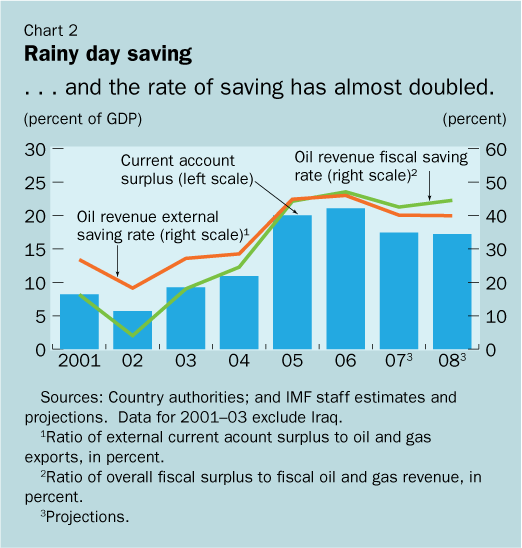MIDDLE EAST AND CENTRAL ASIA

Typical street scene in Santa Ana, El Salvador. (Photo: iStock)
IMF Survey: Riding the Crest of the Oil Boom
October 30, 2007
- Region's oil-exporting countries have saved large portion of their oil revenue
- Higher oil prices allow increased spending, especially investment spending
- Higher spending will help address social, infrastructural development needs
The dramatic increase in world oil prices has resulted in a boom in Middle East and Central Asian oil-exporting countries' receipts for oil and gas exports.

Oil installation in Kuwait: Spending plans imply continued prudent oil revenue management in Middle East, Central Asia region (photo: Yasser al-Zayyat/AFP)
After topping an estimated $650 billion this year, the region's oil exports look set to rise to near $750 billion in 2008 (see Chart 1). This represents an almost fourfold increase from the annual levels at the start of the decade. Between 2004 and 2008, the cumulative additional export revenue (relative to the 2001-02 level) from oil and gas for the region will amount to a staggering $1.9 trillion.
With the public sector accounting for the bulk of oil production in most countries, the export boom has translated into a major boost for the public finances. Government revenue from oil and gas is now estimated at over $510 billion for 2007 and is expected to pick up to about $580 billion in 2008. The cumulative additional fiscal revenue from oil and gas during 2004-08 is projected to amount to $1.5 trillion for all the countries together.

High oil prices have also led to stronger economic growth in the region. During 2001-02, real GDP growth in the region's fourteen oil exporters averaged 4 percent a year. Since then, real output expansion has exceeded 6 percent every year. The growth is raising living standards and creating jobs, both for citizens as well as migrant workers.
Prudent response to price surge
The oil-exporting countries have saved a substantial portion of the oil revenue. Initially, most of them reacted conservatively to the surge in oil prices, treating it as a temporary increase and saving most of the additional income. Some countries also paid down a substantial part of their public debt.
Only after prices climbed further and seemed likely to remain high did countries move ahead with major investment projects. Reflecting this general pattern, the average saving rate of oil export income—measured as the ratio of the region's current account surplus to its oil and gas exports—rose to about 45 percent in 2005-06 compared with an average of about 25 percent during 2001-03 (see Chart 2). Similarly, the average saving of fiscal oil revenue—the ratio of the overall fiscal balance to fiscal receipts from oil and gas—climbed from less than 15 percent to more than 45 percent.

Envisaged spending plans imply continued prudent management of oil revenue in the region as a whole. Most countries have begun implementing major investment projects. The Gulf Cooperation Council countries (Bahrain, Kuwait, Oman, Qatar, Saudi Arabia, and United Arab Emirates) alone have investment spending plans that amount to more than $800 billion over the next five years.
The projects—in roughly equal proportions—are in the oil and gas sectors (funded largely by the national oil companies), infrastructure (mainly under public-private partnership arrangements), and real estate (financed primarily by the private sector).
Oil income saving rates
Thus, oil income saving rates will remain substantial, although they will ease significantly from rates seen in past years. For Middle Eastern and Central Asian oil exporters as a whole, the average saving rate is projected to decline to about 40 percent in 2007-08 for oil export income and above 40 percent for fiscal oil receipts.
The increased spending can be financed easily, even if oil prices were to decline significantly. Although oil earning projections would clearly be affected by movements in oil prices—a decline of $10 a barrel would reduce the region's export receipts by an estimated $90 billion and its fiscal receipts by about $70 billion—the region's external and fiscal positions would remain very comfortable, especially in comparison with the period before the surge in oil prices.
In other words, Middle Eastern and Central Asian oil-exporting countries, in aggregate terms, will be able to undertake their envisaged spending plans and still set aside substantial savings for the future.
Benefits all around
Higher spending will be good for the countries themselves and for the rest of the world. Upgrading infrastructure and social services should boost growth potential, create jobs, and allow the non-oil sectors of the Middle Eastern and Central Asian economies to develop. In many of the countries, needs in these areas are pressing, and the oil boom provides resources to meet them.
Neighboring non-oil-exporting countries are already benefiting from increased exports of goods and labor to the oil-exporting countries. With increased spending by the region's oil exporters, the impact will spread further as their imports from the rest of the world expand. This will be reflected in a sizable narrowing of the region's oil exporters external current account surplus, which is projected to decline from over 20 percent of GDP in 2005-06 to over 17 percent in 2007-08.
Moreover, as the massive investments in oil and gas production and refining reach completion, the world's supply of hydrocarbons will expand to meet growing demand and help alleviate the tightness in energy markets.







